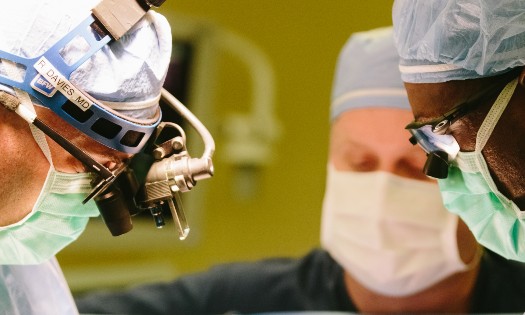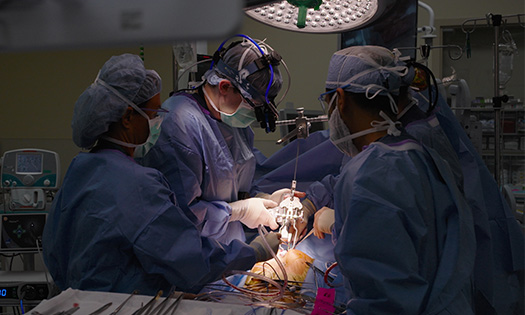Biventricular repair is a cutting-edge innovation that corrects single ventricle heart defects in select children. This surgical advance can reconstruct a heart with a single ventricle circulation into a normal two-ventricle circulation (bi-ventricle). Many children who undergo biventricular repair achieve normal circulation, meaning they’re unlikely to need additional heart surgeries for the ventricle defect later in life.
This is a game-changing improvement over the standard treatment, which involves a series of surgeries that typically end with the Fontan procedure. Some children continue to have blood circulation problems after these surgeries, which puts them at risk for liver failure and heart failure, decreased quality of life and lower survival.
However, biventricular repair is a complex procedure, which makes it challenging to put into practice. The Heart Center at Children’s Health℠ is one of just a few centers in the nation with the expertise to offer it. Nicholas Andersen, M.D., Pediatric Cardiothoracic Surgeon at Children’s Health and Associate Professor at UT Southwestern, is a biventricular repair expert who joined the Heart Center in April 2023 from Duke University and Boston Children’s Hospital. He currently serves as Director of the Complex Biventricular Repair Program and Surgical Director of the Cardiovascular Intensive Care Unit (CICU) at Children’s Health.
Here, Dr. Andersen answers questions about biventricular repair and which patients are likely to benefit.
1. Who is a candidate for biventricular repair?
Children who have borderline left or right ventricle heart defects are good candidates for this surgery. This can include children who have:
Aortic atresia or aortic stenosis
Congenitally corrected transposition of the great arteries (CCTGA)
Double outlet right ventricle (DORV)
2. What are the benefits of biventricular repair?
A child who undergoes biventricular repair will have two functioning ventricles that work like a fully formed heart. They have normal blood circulation and heart function after surgery. Biventricular repair is still fairly new. It’s been in practice for about a decade, so we don’t have complete long-term data yet. However, we aren’t seeing signs of heart failure or liver failure in children who have had this procedure. Survival estimates appear improved in relation to traditional single ventricle operations or heart transplantation.
3. When should biventricular repair take place?
Biventricular repair is most successful when performed on children before 2 to 3 years of age who have working heart valves and other correct structural heart components. We’ve learned that the heart’s growth potential is highest soon after birth. In a perfect situation, we identify these children prenatally and begin discussions with families then. At Children’s Health, we offer virtual and in-person consultations with referring physicians and families to determine the best procedure for a child’s unique heart anatomy.
4. How many biventricular repair procedures does a child need?
A child may need one to three procedures before age 3, depending on their heart anatomy. Some infants need surgery soon after birth to promote blood flow through the smaller ventricle. This helps the ventricle get bigger and stronger, which improves the chances of a successful biventricular conversion six to 12 months later.
I tell families to consider biventricular repair an upfront investment that yields long-term gains. Their child may spend more time in the hospital now, but there’s an excellent chance they’ll have normal blood circulation and never need another heart procedure after completion.
I recently performed a single-stage biventricular repair surgery on a 6-month-old infant with PA/IVS. Another child with a small left ventricle had a hybrid Norwood procedure at birth and biventricular repair at 2 months. I don’t expect either of these children to need additional heart surgeries.
5. What makes Children’s Health biventricular repair program unique?
We took several steps to promote successful patient outcomes before performing our first biventricular repair surgery at the Heart Center. These actions set our biventricular repair program apart from other centers that offer this surgery.
Two heart surgeons on every repair procedure: Children’s Health is unique in that we always have two pediatric heart surgeons taking part in biventricular repairs. This provides double the surgical expertise. It also allows surgeons who are new to the procedure to gain valuable experience.
Experienced OR team: Our highly skilled pediatric cardiac anesthesiologists, perfusionists, nurses and other health care professionals in the operating room received special training in biventricular repair before our first procedure.
3D heart models: Some of these heart defects are extremely complex. Our cardiac imaging team creates a 3D model of each child’s unique heart structures. We use this model to carefully map out the procedure, practice it and make changes before the surgery.
Skilled CICU team: Stabilizing a child’s blood circulation after biventricular repair can be challenging. These children can be very fragile and require specialized support as their hearts heal. Our CICU team completed training to help them identify warning signs of complications so they can take immediate corrective actions.
Connect with Children’s Health heart experts
Children’s Medical Center Dallas, part of the Children’s Health system, is consistently ranked among the top children’s hospitals for cardiology and heart surgery. The Children’s Health Heart Center is a leader in pioneering innovative approaches for complex congenital heart defects. We’re helping to shape the future of pediatric cardiology and cardiac surgery through the use of innovative treatments like biventricular repair.
Learn more about advanced pediatric cardiothoracic surgery at the Children’s Health Heart Center. >>


